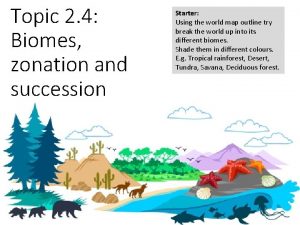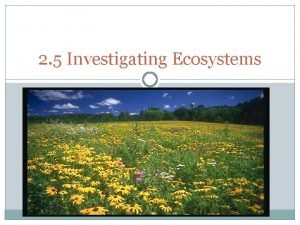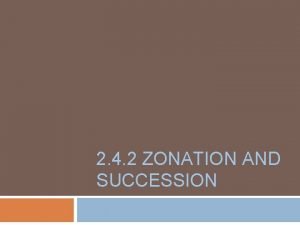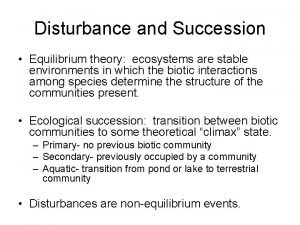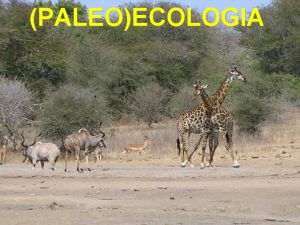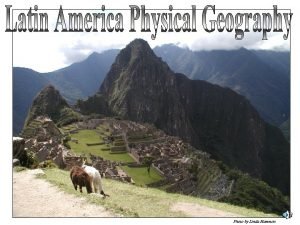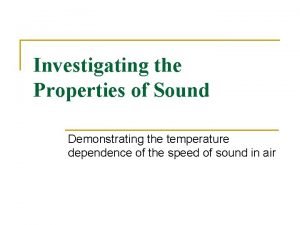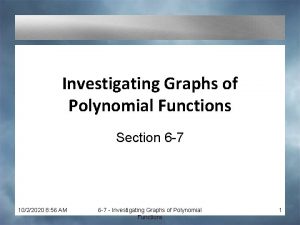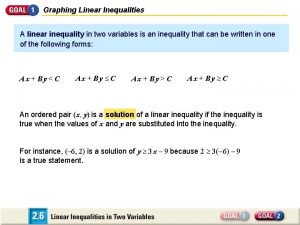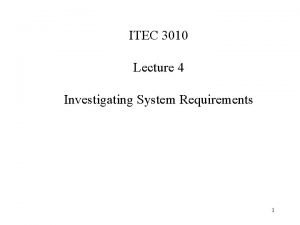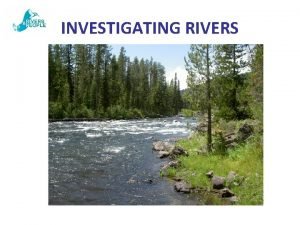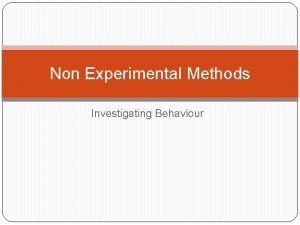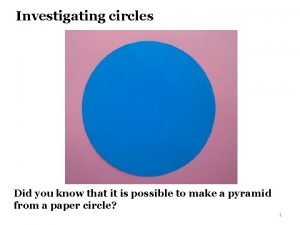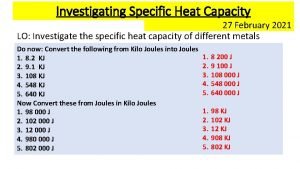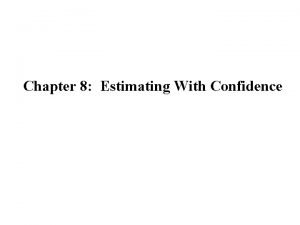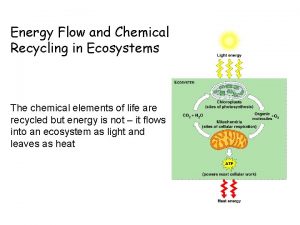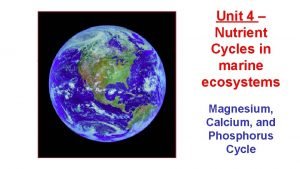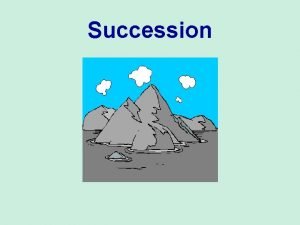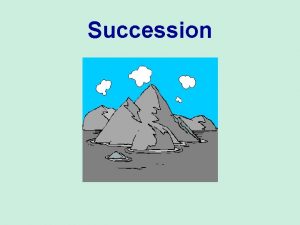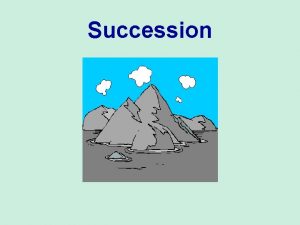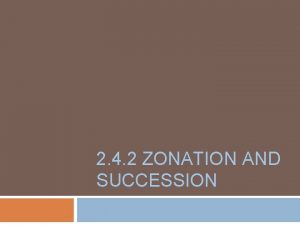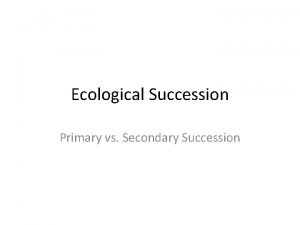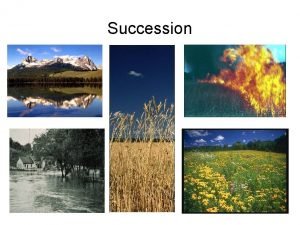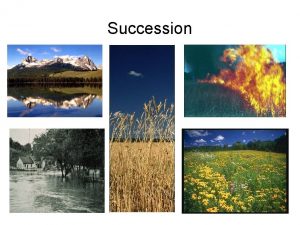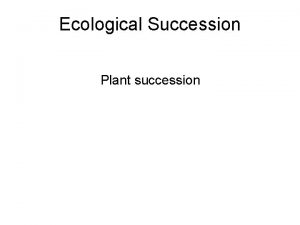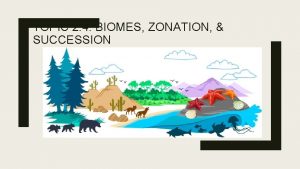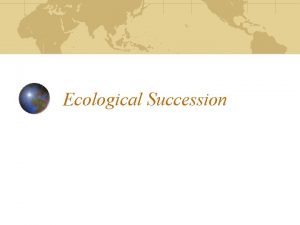2 5 Investigating Ecosystems Review Zonation and Succession
































































- Slides: 64

2. 5 Investigating Ecosystems

Review Zonation and Succession on your notes

Monitoring Abiotic Factors Ecosystems can be roughly divided into: Marine Freshwater and Terrestrial systems

Monitoring Abiotic Factors Complete the diagram in your notes

MONITORING BIOTIC (LIVING) FACTORS Once the abiotic conditions within an environmental gradient have been measured, we can begin to ask questions about the distribution of organisms within the study area Which species are present The size of a particular population of organisms The productivity in a particular area The diversity of a particular area

MONITORING BIOTIC (LIVING) FACTORS Complete the table in your notes

COLLECTING DATA - Where? When collecting environmental data, it is almost impossible to collect every possible data point We use sampling methods to make estimations These methods enable us to get a random sample from an entire ecosystem and then use extrapolation to make estimates and predictions In order to avoid bias it is important that these methods are truly random. Two methods used in ecology to determine where to collect a sample are quadrats and transects.

Assumptions Made When Sampling The sample is representative of the whole system It is necessary to take enough samples so that an accurate representation is obtained It is important to avoid bias when sampling

Estimating Populations of Organisms We estimate populations because it would take way too long to count every living thing in a given ecosystem. We can estimate populations of plants or animals Random Sampling: All organisms must have an equal chance of being captured.

Common Sampling Methods Abundance of Non-motile Organisms Transects and Quadrants Abundance of Motile Organism Actual Count (very difficult if large system) Lincoln Index Capture – Mark - Recapture Species Diversity Simpson Diversity Index For comparing 2 habitats or the change in one habitat over time

Lincoln Index

Measuring abundance of Mobile Organisms If the organism is mobile we use a method called the capture-mark-recapture method We then use this data to calculate the Lincoln Index

How to Capture Motile Organisms REMEMBER: IB Animal Experimentation Policy Pitfall Traps Small Mammal Traps Tullgren Funnels (invertebrates) Kick Net

Estimating Populations of Animals �Lincoln index (capture-mark-release-recapture) n 1 x n 2 N= n 3 • N = Total number of population • n 1 = Number of animals first (mark all of them) • n 2= Number of animals captured in second sample • n 3= Number of marked animals in second sample Ex. 40 mice were caught, marked (tail tattoo) and released. Later, 10 mice were recaptured, 4 of which had tattoo marks.

Lincoln Index

Example 50 snowshoe hares are captured in box traps, marked with ear tags and released. Two weeks later, 100 hares are captured and checked for ear tags. If 10 hares in the second catch are already marked (10%), provide an estimate of N **Realize for accuracy that you would recapture multiple times and take an average**

Lincoln Index Assumptions 1. 2. 3. 4. 5. 6. The marked animals are not affected (neither in behavior nor life expectancy). The marked animals are completely mixed in the population. The probability of capturing a marked animal is the same as that of capturing any member of the population. Sampling time intervals must be small in relation to the total time of experiment of organisms life span. The population is closed (no immigration and emigration) No births or deaths in the period between sampling.

Some Possible Sources of Error Emigration & Immigration Natural disaster or disturbance between captures Trap happy or trap shy individuals Organisms did not have enough time to disperse back into ecosystem Animals lost marks between recapture

Quadrat Sampling

Estimating Populations of Plants Quadrat Estimation Population Density- The number of plants within the given area of the quadrat (m 2) Percentage Coverage. How much of the area of a quadrat is covered by plants? Frequency- How often does a plant occur in each quadrat? Acacia senegalensis was present in 47 of 92 quadrats, for a frequency of 51%

Square Quadrat Method N = (Mean # per quadrat) (total area) Area of each quadrat This estimates the population size in an area Ex. If you count an average of 10 live oak trees per square hectare in a given area, and there are 100 square hectares in your area, then N = (10 X 100 hectare 2) / 1 hectare 2 = 1000 trees in the 100 hectare 2

In addition to population size we can measure… Density = # of individuals per unit area Good measure of overall numbers Frequency = the proportion of quadrats sampled that contain your species Assessment of patchiness of distribution % Cover = space within the quadrat occupied by each species Distinguishes the larger and smaller species

Grid Quadrate Measures percent frequency – the % of quadrats in which the species is found OR Measures percent coverage –the % of area within a quadrat covered by a single species NOTE: When you are looking at one species at a time If not using a 10 x 10, you must turn into a percentage (squares covered/total # of squares)

Percent Frequency

http: //www. slideshare. net/nirmalajosephine 1/biology-form-4 -chapter-8 dynamic-ecosystem-part-3 -42839437

Percent Coverage 1 m Find the percent coverage Count full squares Percent Coverage 18 make full squares Calculate percentage coverage 1 m Now combine pieces to 14 22 24 24 1 2 14 15 3 4 15 17 21 23 19 20 12 13 13 17 18 5 6 12 16 7 8 9 10 11 22 16 19 21 23 20 12

Calculate Population Density What is the population density of species x ? What is the population density of species Y? Quadrat 1= 0. 5 m 2 What is the population density of species Z? X X X W W W X X W X W W z W W Y

Calculate Percentage Coverage What is the percentage of plant coverage in this quadrat? Quadrat 1= 0. 5 m 2 X X W X W X W X X X W W Y

Percentage Frequency Quadrat 1 What is the frequency of species X? What about species V? X W W W X X X X V W W X X W W Z W W Y Quadrat 2 Quadrat 3 Z Z Z W W X X X W W W Z Z W X X W X W Z W W X W W Z W W Y

How choose quadrat size? Think about the size of the organism. Think about the area of the system. The smaller the quadrat the more accurate, however the smaller the sample size Larger quadrats increase inaccuracy but allow for broader sample of an area

Measuring Biomass Get a sample of the organisms, dry them out completely in a dehydrating oven (to remove all water!), find the mass and extrapolate : If you collect 10 plants, dry them out and find their average dry biomass to be 20 g, what would the biomass of a population of 2500 plants be? 50, 000 g Remember – biomass can be used to create pyramids of biomass when looking at energy transfers and is needed for many productivity calculations!

Transets

Transects A TRANSECT - A line, strip or profile of vegetation which has been selected for study. measure any of these abiotic and/or biotic components of an ecosystem along an environmental gradient

Transect In order to complete a transect, a piece of string or measuring tape is laid out along the selected gradient.

Line Transects A measured line is randomly placed across the area in the direction of an environmental gradient All species touching the line are recorded along the whole length of the line or at specific points along the line Measures presence or absence of species

Belt Transects Transect line is laid out and a quadrant is placed at each survey interval Samples are identified and abundance is estimated Slow moving animals (limpets, barnacles, snails) are collected, identified then released For plants an percent coverage is estimated

Belt Transects Data collection should be completed by one individual as estimates can vary person to person

Transect These can either be sampled continuously or as an interrupted transect where samples are taken at regular, fixed distances along the line.

Transect To measure changes in space i. e. zonation, this technique should be completed within a short space of time to avoid any daily cycles For studies of long term change i. e. succession, the transect should be repeated at the same time of day and at regular intervals over a suitable time period depending on what is being studied or assessed.

Kite Diagrams Used to illustrate changes in species over space or time along an environmental gradient. The width of each ‘kite’ represents the percentage cover or abundance of that species.

Simpson Index

Species Diversity The two main factors taken into account when measuring species diversity 1. Richness A measure of the number of different species present in a particular area. The more species present in a sample, the 'richer' the sample. Takes no account of the number of individuals of each species present. It gives as much weight to those species which have very few individuals as to those which have many individuals. http: //www. countrysideinfo. co. uk/simpsons. htm

Species Diversity The two main factors taken into account when measuring species diversity 2. Relative Abundance The relative number of individuals of each species present http: //www. countrysideinfo. co. uk/simpsons. htm

How Can We Know Diversity? Use the Simpsons diversity index below D = ______N (N-1)________ n 1(n 1− 1) + n 2(n 2 − 1) + n 3(n 3 − 1) +…nk(nk − 1) D = Diversity N = Total number of organisms of all species n = number of individuals of a particular species ***The higher the D value the more diverse the sample is!!!!!

Example Data Calculations Abundance of Organism Ecosystem A Ecosystem B species 1 3 5 species 2 7 4 species 3 26 12 species 4 9 7 species 5 7 0 Diversity 3. 27

How can changes in these populations be measured? Necessary because populations may change over time through processes like succession But also because human activities may impact a population and we want to know how Impacts include toxins from mining, landfills, eutrophication, effluent, oil spills, overexploitation

Analyzing Simpson’s Index Used to compare 2 different ecosystems or to monitor an ecosystem over time D values have no units and are used as comparison to each other High D Value Indicates: Stable and ancient site More diversity Healthy habitat Low D Value Indicates: Dominance by one species Environmental stress Pollution, colonization, agriculture

How to Capture Motile Organisms REMEMBER: IB Animal Experimentation Policy Pitfall Traps Small Mammal Traps Tullgren Funnels (invertebrates) Kick Net

Classification

What is classification? Science of grouping organisms based on their physical characteristics.

What characteristics do we use? Structures (morphology) Functions (physiology) Biochemistry Genetics

Why do we classify? Identify organisms Compare organisms Identify relationships among organisms Communicate with others (universal language) Identify evolutionary relationships

Why do we classify? What am I? Firefly Lightning bug Glow Fly Blinkie Golden Sparkler Moon bug Glühwürmchen Luciérnaga Luciole We all have different names for the same organism…this is a problem for communication.

From Aristotle to Linneaus Aristotle (Greek philosopher) (384 -322 B. C) First System of Classification 1. Plants Based on stem type 2. Animals Land, air or water

From Aristotle to Linneaus Carolus Linneaus (Sweedish botanist) (1707 -1778) Came up with modern classification system Used binomial nomenclature (2 word naming system) This two word name is called a scientific name Composed of the genus name followed by the species name

Scientific Names Either written in italics or underlined Genus is always capitalized and species is always lowercase Based on Latin Examples: Cat: Felix domesticus Mosquito: Colex pipens Human: Homo sapien

Funny Scientific Names Agra vation (a beetle) Colon rectum (another beetle) Ba humbugi (a snail) Aha ha ( a wasp) Lalapa lusa (a wasp) Leonardo davinci (a moth) Abra cadabra (a clam) Gelae baen, Gelae belae, Gelae donut, Gelae fish, and Gelae rol (all types of fungus beetles) Villa manillae, Pieza kake and Reissa roni (bee flies)

Dichotomous Keys A series of yes/no questions about an organisms structure Used to identify new and unknown organisms

Step 1: Identify the organism Use dichotomous keys, field guides, observe a museum collection, or consult an expert http: //www. earthlife. net/insects/orders- key. html#key Sample key for insect ID http: //people. virginia. edu/~sos-iwla/Stream. Study/Key 1. HTML Macroinvertebrate key

Example of Dichotomous Key 1 a. Hair Present…………. . Class Mammalia 1 b. Hair Absent……………Go to statement 2

Example of Dichotomous Key 2 a. Feathers present…………. . Class Aves 2 b. Feathers absent……………. Go to statement 3 3 a. Jaw Present…………………. . Go to statement 4 3 b. Jaw Absent…………Class Agnatha

Example of Dichotomous Key 4 a. Paired fins present……………Go to 5 4 b. Paired fins absent……………. Go to 6

Example of Dichotomous Key 6 a. Skin scales present………………Class Reptilia 6 b. Skin scales absent………………. Class Ampibia

Review points 1. 2. 3. 4. 5. Dispersion patterns Carrying capacity and limiting factors r and K selection Natural population cycles Human effects
 Prediction explanation
Prediction explanation Zonation and succession
Zonation and succession Parasitism
Parasitism Succession vs zonation
Succession vs zonation Succession definition
Succession definition Succession equilibrium in ecosystems
Succession equilibrium in ecosystems Ecological succession succession of a pond
Ecological succession succession of a pond Ecological succession succession of a pond
Ecological succession succession of a pond Chapter 4 ecosystems and communities vocabulary review
Chapter 4 ecosystems and communities vocabulary review Bioma akuatik
Bioma akuatik Vertical zonation
Vertical zonation Linda hammon
Linda hammon Talent review succession planning
Talent review succession planning Investigating and making a case for drug diversion
Investigating and making a case for drug diversion Cell theory contributors
Cell theory contributors Investigating the properties of sound
Investigating the properties of sound Investigating science hsc
Investigating science hsc Practice a investigating graphs of polynomial functions
Practice a investigating graphs of polynomial functions Investigating graphs of polynomial functions
Investigating graphs of polynomial functions Unit 14 investigating customer service
Unit 14 investigating customer service Investigating the world of work. lesson 1
Investigating the world of work. lesson 1 6-7 investigating graphs of polynomial functions
6-7 investigating graphs of polynomial functions Unit 14 investigating customer service assignment 1
Unit 14 investigating customer service assignment 1 Investigating the graph of an inequality
Investigating the graph of an inequality Creative imedia r082
Creative imedia r082 Investigating polynomials
Investigating polynomials Investigating system requirements
Investigating system requirements Module 1 review questions
Module 1 review questions Oxbow lake formation
Oxbow lake formation Investigating graphs of polynomial functions
Investigating graphs of polynomial functions Investigating quadratics
Investigating quadratics Investigating rivers
Investigating rivers Investigating skills thomas edison
Investigating skills thomas edison Written observation example
Written observation example Integrated science lab experiments
Integrated science lab experiments What is this
What is this Language meaning
Language meaning Investigating system requirements
Investigating system requirements Investigating specific heat capacity
Investigating specific heat capacity Suppose your class is investigating the weights of snickers
Suppose your class is investigating the weights of snickers Epiphytes plants
Epiphytes plants Why biomes are important
Why biomes are important Chapter 55 ecosystems and restoration ecology
Chapter 55 ecosystems and restoration ecology Chapter 42 ecosystems and energy
Chapter 42 ecosystems and energy Chapter 3 lesson 3 biomes and aquatic ecosystems
Chapter 3 lesson 3 biomes and aquatic ecosystems Aquatic vs terrestrial
Aquatic vs terrestrial Regents biology food chains and energy in ecosystems
Regents biology food chains and energy in ecosystems Phosphorus cycle
Phosphorus cycle Lab food chains and energy in ecosystems
Lab food chains and energy in ecosystems Flow of energy
Flow of energy Chapter 55 ecosystems and restoration ecology
Chapter 55 ecosystems and restoration ecology Biomes and aquatic ecosystems
Biomes and aquatic ecosystems Water pollution impact on ecosystem
Water pollution impact on ecosystem 5 oceans of the world
5 oceans of the world Parasitism examples
Parasitism examples Orderly natural changes and species replacements
Orderly natural changes and species replacements Chapter review motion part a vocabulary review answer key
Chapter review motion part a vocabulary review answer key Uncontrollable spending ap gov
Uncontrollable spending ap gov Nader amin-salehi
Nader amin-salehi Traditional and systematic review venn diagram
Traditional and systematic review venn diagram Narrative review vs systematic review
Narrative review vs systematic review Magnesium cycle in marine ecosystem
Magnesium cycle in marine ecosystem Lesson outline lesson 2 aquatic ecosystems answer key
Lesson outline lesson 2 aquatic ecosystems answer key Section 3 aquatic ecosystems worksheet answers
Section 3 aquatic ecosystems worksheet answers Ecosystem living and nonliving things
Ecosystem living and nonliving things
